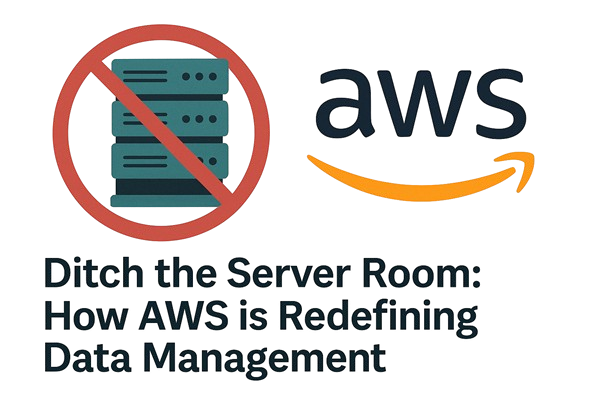
Ditch the Server Room: How AWS is Redefining Data Management:
From Server Rooms to the Cloud: A Revolution Begins
Once upon a time, every business had a server room — a climate-controlled, blinking-heartbeat of the company’s IT infrastructure. It was noisy, expensive, high-maintenance, and constantly on the verge of needing upgrades. But then came a seismic shift:
“Ditch the server room.”This wasn’t just a cost-saving tactic — it was a philosophical and operational overhaul.And leading that revolution was none other than Amazon Web Services (AWS).
The Ideology Behind AWS: Think Big, Build Fast
Launched in 2006, AWS emerged with a clear, disruptive vision:
Why should businesses build and maintain their own infrastructure when it could be rented like electricity?This idea wasn’t just innovative — it was liberating. With pay-as-you-go pricing, scalability on demand, and global reach,AWS democratized IT power, making it available to startups, enterprises, and governments alike.
AWS redefined data management by treating infrastructure as a service — not a burden.
How AWS Captured the Market
AWS didn’t just offer cloud storage. It provided:
- Elastic Compute Cloud (EC2): Dynamic virtual machines at your fingertips.
- S3 (Simple Storage Service): Infinite, reliable, low-cost object storage.
- RDS: Managed relational databases without maintenance headaches.
- Redshift: Data warehousing for high-speed analytics at scale.
Add to that developer tools, machine learning, security and data migration services, and AWS became a one-stop powerhouse for digital transformation.
By 2024, AWS holds over 30% of the global cloud market, dwarfing competitors like Azure and Google Cloud.
What Traditional Databases Couldn't Offer
Let’s compare AWS with traditional SQL and Oracle-based environments:
| Feature | Traditional SQL/Oracle | AWS |
|---|---|---|
| Scalability | Manual scaling, downtime risk | Auto-scaling, elastic infrastructure |
| Upfront Cost | Expensive hardware/software | Pay-as-you-go, zero capex |
| Maintenance | Manual updates, dedicated IT team | Managed services, automated patching |
| Availability | Prone to outages | 99.99% uptime with global data centers |
| Security | On-prem security layers | Built-in compliance, end-to-end encryption |
AWS eliminates the physical limitations and financial inefficiencies of traditional data infrastructure.
AWS by the Numbers
- Over 1 million active customers in 190 countries
- 220+ fully featured services available
- AWS Marketplace has 12,000+ software listings
- Over 80 availability zones in 25 geographic regions
From Netflix to NASA, startups to governments — everyone’s moving to the cloud.
Why Businesses Trust AWS Today
- Compliance-ready for industries like healthcare, finance, and public sector.
- Disaster recovery & backup built into cloud services.
- Serverless options with AWS Lambda for microservices and event-driven tasks.
- Global CDN (CloudFront) ensures lightning-fast performance.
AWS didn’t just take the server room and put it online.
It reimagined what data infrastructure could be: scalable, affordable, and global from Day 1.
In a world that demands agility and efficiency, it’s no surprise businesses are saying:
“Why host servers when AWS can do it better?”